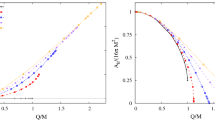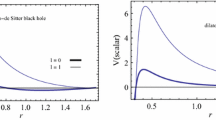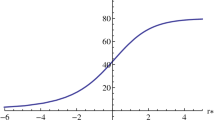Abstract
The Dirac quasinormal modes of Einstein–Born–Infeld dilaton black holes are studied. We separate the Dirac equation in the curve spacetime into radial and angular parts by Newman–Penrose formalism, and we fortunately obtain the exact analytical solutions of these equations. Then we get the analytical expressions for the quasinormal modes of the black hole. Our results show that the quasinormal frequencies are purely imaginary which means the black hole is very stable. Furthermore, we find that the area spacing of the black hole is described by \(\Delta A_{min}=8\pi \hbar \) which supports Bekenstein’s conjecture.



Similar content being viewed by others
References
Einstein, A.: Die Grundlage der allgemeinen Relativitätstheorie. Ann. Phys. 49, 769–822 (1916)
Gibbons, G.W.: Vacuum polarization and the spontaneous loss of charge by black holes. Commun. Math. Phys. 44, 245 (1975)
Schwarzschild, K.: Sitzungsber. Preuss. Akad.Wiss. Berlin.: On the gravitational field of a mass point according to Einstein’s theory. Math. Phys. 1916, 189 (1916)
Misner, C.W., Thorne, K.S., Wheeler, J.A.: Gravitation. W. H. Freeman, San Francisco (1973)
Frolov, V.P., Novikov, I.D.: Black Hole Physics: Basic Concepts and New Developments. Kluwer Academic, Dordrecht (1998)
Vishveshwara, C.V.: Stability of the Schwarzschild metric. Phys. Rev. D 1, 2870 (1970)
Vishveshwara, C.V.: Scattering of gravitational radiation by a Schwarzschild black-hole. Nature 227, 936 (1970)
Abbott, B.P., et al.: [LIGO Scientific and Virgo Collaborations] Observation of gravitational waves from a binary black hole merger. Phys. Rev. Lett. 116(6), 061102 (2016)
Abbott, B.P., et al.: [LIGO Scientific and Virgo Collaborations] GW151226: observation of gravitational waves from a 22-Solar-Mass binary black hole coalescence. Phys. Rev. Lett. 116(24), 241103 (2016)
Abbott, B.P., et al.: [LIGO Scientific and Virgo Collaborations] GW170104: observation of a 50-Solar-Mass binary black hole coalescence at redshift 0.2. Phys. Rev. Lett. 118(22), 221101 (2017)
Lepe, S., Saavedra, J.: Quasinormal modes, superradiance and area spectrum for acoustic black holes. Phys. Lett. B 617, 174 (2005)
Aros, R., Martinez, C., Troncoso, R., Zanelli, J.: Quasinormal modes for massless topological black holes. Phys. Rev. D 67, 044014 (2003)
Jing, J.: Dirac quasinormal modes of Schwarzschild black hole. Phys. Rev. D 71, 124006 (2005)
Jing, J., Pan, Q.: Dirac quasinormal frequencies of Schwarzschild-anti-de Sitter and Reissner–Nordström-anti-de Sitter black holes. Phys. Rev. D 71, 124011 (2005)
Jing, J., Pan, Q.: Quasinormal modes and second order thermodynamic phase transition for Reissner–Nordström black hole. Phys. Lett. B 660, 13 (2008)
Maggiore, M.: Physical interpretation of the spectrum of black hole quasinormal modes. Phys. Rev. Lett. 100, 141301 (2008)
Chen, S., Jing, J.: Dynamical evolution of a scalar field coupling to Einstein’s tensor in the Reissner–Nordström black hole spacetime. Phys. Rev. D 82, 084006 (2010)
Wang, B., Abdalla, E., Mann, R.B.: Scalar wave propagation in topological black hole backgrounds. Phys. Rev. D 65, 084006 (2002)
Konoplya, R.A.: Quasinormal behavior of the D-dimensional Schwarzschild black hole and higher order WKB approach. Phys. Rev. D 68, 024018 (2003)
Wang, M., Herdeiro, C.: Maxwell perturbations on Kerr-anti-de Sitter black holes: quasinormal modes, superradiant instabilities, and vector clouds. Phys. Rev. D 93, 064066 (2016)
Fernando, S., Arnold, K.: Scalar perturbations of charged dilaton black holes. Gen. Relativ. Gravit. 36, 1805 (2004)
Yao, W.P., Chen, S., Jing, J.: Quasinormal modes of a scalar perturbation coupling with Einstein’s tensor in the warped AdS3 black hole spacetime. Phys. Rev. D 83, 124018 (2011)
Wang, M., Herdeiro, C., Jing, J.: Dirac perturbations on Schwarzschild-anti-de Sitter spacetimes: generic boundary conditions and new quasinormal modes. Phy. Rev. D 96, 104035 (2017)
Xu, J.Y., Jing, J.: Dirac quasinormal modes and area spectrum of Horava–Lifshitz black holes. Ann. Phys. 389, 136 (2018)
González, P.A., Papantonopoulos, E., Saavedra, J., Vásquez, Y.: Superradiant instability of near extremal and extremal four-dimensional charged hairy black holes in anti-de Sitter spacetime. Phys. Rev. D 95, 064046 (2017)
Zangeneh, M.K., Wang, B., Sheykhi, A., Tang, Z.Y.: Charged scalar quasi-normal modes for linearly charged dilaton-Lifshitz solutions. Phys. Lett. B 771, 257–263 (2017)
Hashemi, S.S., Zangeneh, M.K., Faizal, M.: Charged scalar quasi-normal modes for higher-dimensional Born-Infeld dilatonic black holes with Lifshitz scaling. arXiv:1901.11367
Bekenstein, J.D.: The quantum mass spectrum of the Kerr black hole. Lett. Nuovo Cim. 11, 467 (1974)
Hod, S.: Bohr’s correspondence principle and the area spectrum of quantum black holes. Phys. Rev. Lett. 81, 4293 (1998)
Kunstatter, G.: D-dimensional black hole entropy spectrum from quasi-normal modes. Phys. Rev. Lett. 90, 161301 (2003)
Born, M.: On the quantum theory of the electromagnetic field. Proc. R. Soc. Lond. A 143(849), 410 (1934)
Born, M., Infeld, L.: Foundations of the new field theory. Proc. R. Soc. Lond. A 144, 425 (1934)
Johnson, C.V.: D-Branes. Cambridge Monographs on Mathematical Physics. Cambridge University Press, Cambridge (2002)
Zwiebach, B.: A First Course in String Theory. Cambridge University Press, Cambridge (2009)
Leigh, R.G.: Dirac–Born–Infeld action from dirichlet \(\sigma \)-model. Mod. Phys. Lett. A 4, 2767 (1989)
Tseytlin, A.A.: Vector field effective action in the open superstring theory. Nucl. Phys. B 276, 391 (1986)
Jing, J., Chen, S.: Holographic superconductors in the Born–Infeld electrodynamics. Phys. Lett. B 686, 68 (2010)
Jing, J., Wang, L., Pan, Q., Chen, S.: Holographic superconductors in Gauss–Bonnet gravity with Born–Infeld electrodynamics. Phys. Rev. D 83, 066010 (2011)
Yao, W., Jing, J.: Analytical study on holographic superconductors for Born-Infeld electrodynamics in Gauss–Bonnet gravity with backreactions. JHEP 1305, 101 (2013)
Yao, W., Jing, J.: Holographic entanglement entropy in insulator/superconductor transition with Born–Infeld electrodynamics. JHEP 1405, 058 (2014)
Yao, W., Jing, J.: Holographic entanglement entropy in metal/superconductor phase transition with Born–Infeld electrodynamics. Nucl. Phys. B 889, 109 (2014)
Wang, L., Jing, J.: General holographic superconductor models with Born–Infeld electrodynamics. Gen. Relativ. Gravit. 44, 1309 (2012)
Yamazaki, R., Ida, D.: Black holes in three-dimensional Einstein–Born–Infeld-dilaton theory. Phys. Rev. D 64, 024009 (2001)
Sheykhi, A., Riazi, N., Mahzoon, M.H.: Asymptotically nonflat Einstein–Born–Infeld-dilaton black holes with Liouville-type potential. Phys. Rev. D 74, 044025 (2006)
Wiltshire, D.L.: Spherically symmetric solutions in dimensionally reduced spacetimes with a higher-dimensional cosmological constant. Phys. Rev. D 44, 1100 (1991)
Mignemi, S., Wiltshire, D.L.: Black holes in higher-derivative gravity theories. Phys. Rev. D 46, 1475 (1992)
Poletti, S.J., Wiltshire, D.L.: Erratum: Global properties of static spherically symmetric charged dilaton spacetimes with a Liouville potential [Phys. Rev. D 50, 7260 (1994)]. Phys. Rev. D 52, 3753 (1995)
Clément, G., Gal’tsov, D., Leygnac, C.: Linear dilaton black holes. Phys. Rev. D 67, 024012 (2003)
Cai, R., Wang, A.: Nonasymptotically AdS/dS solutions and their higher dimensional origins. Phys. Rev. D 70, 084042 (2004)
Destounis, K., Panotopoulos, G., Rincón, Á.: Stability under scalar perturbations and quasinormal modes of 4D Einstein–Born–Infeld dilaton spacetime: exact spectrum. Eur. Phys. J. C 78(2), 139 (2018)
Sakalli, I., Jusufi, K., Övgün, A.: Analytical solutions in a cosmic string Born–Infeld-dilaton black hole geometry: quasinormal modes and quantization. Gen. Relativ. Gravit. 50, 125 (2018)
Chandrasekhar, S., Detweiler, S.: The quasi-normal modes of the Schwarzschild black hole. Proc. R. Soc. A 344, 441 (1975)
Panotopoulos, G., Rincón, Á.: Greybody factors for a minimally coupled massless scalar field in Einstein–Born–Infeld dilaton spacetime. Phys. Rev. D 96, 025009 (2017)
Page, D.N.: Dirac equation around a charged, rotating black hole. Phys. Rev. D 14, 1509 (1976)
Newman, E., Penrose, R.: An approach to gravitational radiation by a method of spin coefficients. J. Math. Phys. (N. Y.) 3, 566–578 (1962)
Arfken, G.B., Weber, H.J.: Mathematical Methods for Physicists. Elsevier Academic Press, Cambridge (2005)
Abramowitz, M.: Handbook of Mathematical Functions, with Formulas, Graphs, and Mathematical Tables. Dover Publications Incorporated, Mineola (1974)
Acknowledgements
This work is supported by the National Natural Science Foundation of China under Grant No. 11875025.
Author information
Authors and Affiliations
Corresponding author
Additional information
Publisher's Note
Springer Nature remains neutral with regard to jurisdictional claims in published maps and institutional affiliations.
Rights and permissions
About this article
Cite this article
Chen, Y., Jing, J. Quasinormal modes of Dirac field in Einstein–Born–Infeld dilaton black hole. Gen Relativ Gravit 51, 73 (2019). https://doi.org/10.1007/s10714-019-2554-x
Received:
Accepted:
Published:
DOI: https://doi.org/10.1007/s10714-019-2554-x




